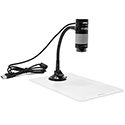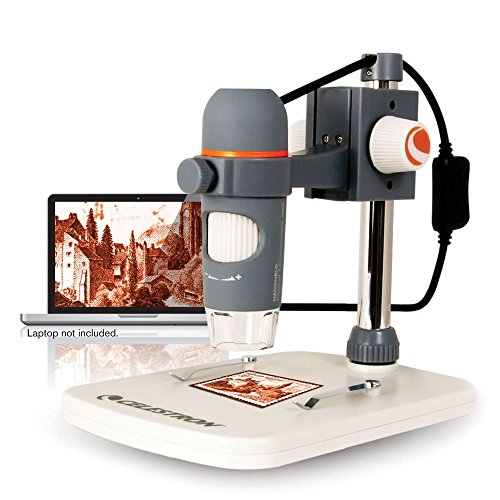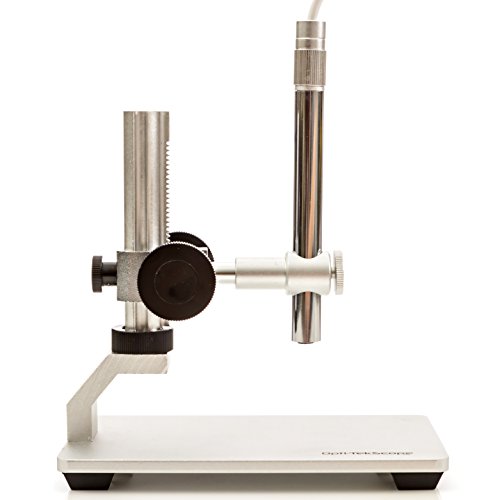5 Best Digital USB Microscopes of 2025 – Top Picks & Reviews
Last Updated on

Today, you can get an effective, high-quality USB microscope with image quality that puts some optical models to shame, for a price that won’t leave you gasping.
Unfortunately, it can be hard to shop for these great tools online. There are a ton of them out there, and sorting the great models from the frustrating ones can seem like an impossible task.
We’ve done the hard work for you. We’ve reviewed some of the best USB microscopes so you can find the best model for your task. Also included is a buyer’s guide, where we cover the information you need to know to find the right microscope for you, at a price you’ll love, too.

Summary of our Favorites (updated in 2025)
| Image | Product | Details | ||
|---|---|---|---|---|
| Best Overall |
 |
Celestron 5 MP |
|
CHECK PRICE |
 |
Opti-Tekscope Digital |
|
CHECK PRICE | |
| Best Value |
 |
Plugable USB 2.0 |
|
CHECK PRICE |
 |
Jiusion Digital |
|
CHECK PRICE | |
 |
DEPSTECH USB 2.0 |
|
CHECK PRICE |
The 5 Best Digital USB Microscopes
1. Celestron 5 MP USB Microscope – Best Overall
The Celestron 5 MP Handheld Digital Microscope Pro is the best overall USB microscope we looked at. It has a five-megapixel camera, which produces very clear, high-quality images. This model comes with a long magnification range, as you can zoom from 20x to 200x. That makes it more versatile than many optical microscopes at the same price point. It comes with super-easy, barrel-mounted focusing. This is the one to get if you want great image clarity that’s easy to produce.
It also has excellent lighting. Bright light means you can make out more detail and get better images. The only thing we don’t like is that it requires repeated calibration with its measuring tool. While not everyone will be using the measuring tool regularly, teachers who are using this scope in their classes won’t like having to recalibrate every time it’s turned on. Still, if you’re looking for a microscope with top image quality, you’ll love this one.
- image clarity
- Excellent magnification
- Easy focusing
- Great lighting
- Requires repeated calibration
2. Opti-Tekscope Digital USB Microscope
The Opti-Tekscope Digital USB Microscope has a clean look, and there are many reasons most users really like this model. Its durable aluminum shell not only looks great, but makes it both very lightweight and sturdy. Something else most people love is its native compatibility with the Photos application on Windows 10. There’s no installation required on Windows 10, though you can install the first-party software if you want. This scope also has up to 200x magnification, so you can make out a lot of detail on small objects.
When it comes to lighting, this model is arguably better than the top one we reviewed. While the previous scope has iffy light adjustment, this one has a large brightness range due to its eight LED lights. That lets you squeeze extra clarity out of images, even if the camera isn’t natively as good as some on other models. What ultimately keeps this one out of first place is that it doesn’t come with any measurement options. However, it costs slightly less, so if you’re looking for a less expensive, but still high-quality experience, you’ll do just fine with this model.
- Up to 200x magnification
- Easy Windows 10 compatibility
- Aluminum body
- Adjustable lighting
- Lacks measurement options
3. Plugable USB Microscope – Best Value
The Plugable USB 2.0 Digital Microscope is a great microscope for the scientist on a budget. It’s capable of up to 250x magnification, making it the clear champion in that area among the microscopes here. It also comes with an easy-to-adjust light wheel on the microscope’s body, which lets you make changes quickly. Plus, this is an Oculus Rift-compatible USB microscope, so if you’re looking to take your experience into VR, you’ll be very happy with it.
The best thing about this model is its price. It costs less than half of what the top two models we reviewed cost. That’s incredible given that it has a higher maximum magnification. The great price and awesome performance earn this microscope the title of “best overall value for the money” on our list. What ultimately keeps it out of first place is that it isn’t great with slides that you would use with other microscopes, and they often turn out blurry. However, if you’re looking to view larger objects and want to save a little money with your purchase, this is easily the one you’ll want.
- Excellent magnification
- Easy brightness adjustment
- Oculus Rift-compatible
- Great price
- Doesn’t work with slides
4. Jiusion Digital USB-Microscope
The Jiusion 40 to 1000x Magnification Digital USB Microscope is roughly as expensive as the previous model reviewed, so if it had really high value, it would be a contender for overall best USB microscope. It has a USB port and a WiFi adapter, so you can use it on a computer or on a smartphone. That wide range of supported devices makes it versatile and good for use in field work, where you may find yourself far from a computer. This model also has incredible magnification, going from 40x to 1000x, in theory.
In practice, it requires special software to work. It ships with an undersized CD, from which you won’t be able to install the software. It’s hard to find online, and software packages sent by customer support seem to fail universally on installation. Without that software, this microscope is unable to zoom, making it basically a low-resolution camera. It also comes with an underwhelming stand that’s prone to shaking. Overall, this model is nice in theory but fails in multiple critical areas.
- Wireless
- Incredible magnification
- Wide range of compatible devices
- Underwhelming stand
- Unusable software
5. DEPSTECH USB 2.0 Microscope
The DEPSTECH USB 2.0 Digital Microscope is another model with excellent lighting. It comes with eight LED lights for great maximum lighting, though they aren’t as easily adjustable as the lights on other models. It also boasts up to 1200X magnification, though we’re not sure that it lives up to those claims. 1200x optical microscopes can see individual cells, though these have been prepared on a slide, which you can’t use with this model. However, this scope does come with a measuring rule, though it doesn’t have the digital measuring options that the best model on this list includes.
The worst thing about this microscope is the poor overall quality. The parts aren’t well-made, which is something you could guess based on the price. If you’re looking for a tool that will last forever, this isn’t it. It also doesn’t work with Windows 10, which is now the most common version of Windows and the most common computer operating system worldwide. Given those flaws, there aren’t many people who will get a lot of value from this one, even given its overall low price.
- Eight LED lights
- 1200x maximum magnification
- Includes measuring rule
- Poor overall quality
- Doesn’t work with Windows 10

Buyer’s Guide
You may have a few questions remaining. That’s okay! We know that it can sometimes be difficult to decide between models with which you’re not terribly familiar. This guide is designed to bring you up to speed so you can return to our list and evaluate our selected models expertly. Plus, if you’re a value shopper, we’ve included some tips on maximizing the bang for your buck. If you want to invest in a great microscope that saves you money at the same time, make sure you read this guide.
CMOS sensors
The most important thing to understand when shopping for a USB microscope is the CMOS sensor. CMOS stands for complementary metal oxide semiconductor, and these sensors are used in devices like digital cameras. In this case, they’re the device that allows a USB microscope to function.
These chips feature little light-capturing cells that produce electrical current when hit by certain wavelengths of light. The currents are amplified and then combined to produce a full image. CMOS chips are inexpensive to produce, which means you can get a USB microscope at a good price.
A CMOS sensor’s quality is measured in megapixels. The best models we reviewed come with eight-megapixel sensors, which are good enough for use in professional-quality digital cameras.
Note that megapixels don’t scale linearly. To double an image’s resolution, you’d need to quadruple the megapixels. Consequently, you wouldn’t see a big difference in image quality between a six-megapixel and an eight-megapixel sensor. However, the smallest model reviewed here comes with a .3-megapixel sensor, making it one-quarter the resolution of the best model.
Illumination
Illumination is another area where the best USB microscopes differ greatly from the worst models. It’s important to pay attention to both the maximum brightness and the adjustability of that brightness.
The brightest models use energy-efficient LED lights. This is important because USB ports can only provide so much power. LED lights give great illumination without drawing too much on the USB port. Look for six to eight lights so you can get a good level of brightness, as increased brightness reveals more detail.
However, you won’t always want the brightness at its maximum. Shiny or reflective surfaces will be more visible at lower light levels. On the other hand, dark, non-reflective materials benefit greatly from the extra light.
Most USB microscopes come with adjustable brightness. Less convenient models have their controls on their cord, or worse, on the computer itself, while highly convenient models have the controls on the microscope’s body. That makes it easy to get the image quality you’re searching for without having to hunt for a control panel.
Magnification
USB microscopes work fundamentally differently than optical microscopes. Optical microscopes rely on slides. Slides feature a thin sample of a material pressed between two clear sheets of plastic or glass. Because you’re looking at a thin slice of something, organic or not, you’ll be able to make out finer detail than you would with a USB microscope. For example, you can’t make out individual cells with a USB microscope.
However, USB microscopes are great for examining the outer structures of solid objects, which is something optical microscopes will never be able to do.
At 40x magnification, which is the minimum many USB microscopes provide, you could potentially see very large cells. At 100x magnification, you have enough zoom to see the largest bacteria, though they will look like tiny dots.
Most digital USB microscopes top out somewhere between 200x and 400x magnification. With an optical microscope and 400x magnification, you could potentially look inside cells and see their internal components. With a USB microscope, you’d be able to enjoy a high-resolution look at the outer shells of the organic or inorganic material you’re looking at.
While some USB microscopes feature 1000x magnification or greater, keep in mind that you need a very stable stand, as any shaking will render the image unviewable.
Computer compatibility
One of the most frustrating potential problems with a USB microscope is if it’s not compatible with your computer. It’s extremely important to confirm the models with which your preferred computer works before you order.
Of course, some models are easier to use than others. Some are natively compatible with Windows 10’s Photos app, so you won’t have to install any software before you get to work.
Many models come with software on a CD. In the past, this wasn’t a big deal, but many lightweight, slim computers, such as the MacBook Air or Google Chromebook, don’t have CD drives. In some situations, that will mean you can’t use the USB microscope at all. You should be able to find most necessary software packages online, but check the manufacturer’s website before you buy, especially if you don’t have a CD drive.
Wireless capabilities
Some USB microscopes have wireless capabilities. Some accomplish this by having you plug the USB into a wireless adapter. Other times, the wireless chip is contained within the body of the microscope.
Keep in mind that sometimes the connection is powered by Wi-fi. This means you need to be near a Wi-fi network in order to use the USB microscope at all.
Other models are powered by Bluetooth. These can connect with smartphones, many laptops, and even some desktops, so you can use them on a wider range of devices. Some Wi-fi powered USB microscopes will connect to smartphones, though you’ll need to install an app on your phone to use it with your microscope.
Which USB microscope is right for you?
When it comes to shopping for USB microscopes, many people go about it in a way that leaves them with a model they don’t like. That’s a problem that gets even worse when you spend a lot of money on a scope and hope that it comes through for you.
It’s better to evaluate your needs first. Decide what kinds of things you’ll want to do with your USB microscope. Then determine what features will make that possible. Don’t worry about the price just yet; instead, find the models with the features you need.
Your shortlist should only be composed of models with all those features. Any that don’t are likely to leave you frustrated, regardless of price. Now, it’s safe to rank them by cost. Then, choose the most affordable one. It will give you a great experience, since you’ve already selected the features you need, and since the price is the lowest, it provides excellent value for the money.
We’ve covered this question more in-depth in this article.

Conclusion
The Celestron 5 MP Handheld Digital Microscope Pro boasts good image clarity, excellent magnification, and easy focusing, which earn it the top spot here. In second is the Opti-Tekscope Digital USB Microscope, which features an aluminum body, easy compatibility with Windows 10, and adjustable lighting, though it lacks measurement options. The Plugable USB 2.0 Digital Microscope comes with excellent magnification and easy brightness adjustment, and since you can get it for a fraction of the price of our top two models, it’s the best value for the money on our list. The Jiusion 40 to 1000x Magnification Digital USB Microscope has incredible magnification and wireless operation, but it is hamstrung by its poor software delivery, which drops it to fourth place. The last place is taken by the DEPSTECH USB 2.0 Digital Microscope, which has good brightness and a measure rule. However, its poor overall quality and lack of Windows 10 compatibility cost it a ton of value.
We hope these reviews and this guide can help you learn everything you need to know about USB microscopes and lead you to the model that is right for you.
Related reviews:
About the Author Robert Sparks
Robert’s obsession with all things optical started early in life, when his optician father would bring home prototypes for Robert to play with. Nowadays, Robert is dedicated to helping others find the right optics for their needs. His hobbies include astronomy, astrophysics, and model building. Originally from Newark, NJ, he resides in Santa Fe, New Mexico, where the nighttime skies are filled with glittering stars.
Related Articles:
How to Clean a Refractor Telescope: Step-by-Step Guide
How to Clean a Telescope Eyepiece: Step-by-Step Guide
How to Clean a Rifle Scope: 8 Expert Tips
Monocular vs Telescope: Differences Explained (With Pictures)
What Is a Monocular Used For? 8 Common Functions
How to Clean a Telescope Mirror: 8 Expert Tips
Brightfield vs Phase Contrast Microscopy: The Differences Explained
SkyCamHD Drone Review: Pros, Cons, FAQ, & Verdict








